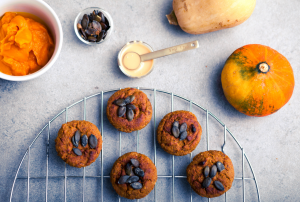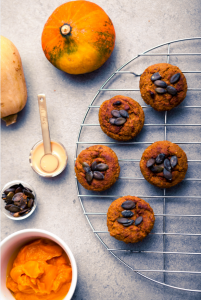Fünf Kürbisarten werden kultiviert. Der Garten-, Riesen und Moschus- Kürbis sind die drei wichtigsten Arten. Kürbisse waren bis auf das 16. Jahrhundert auf Amerika beschränkt. In der Zwischenzeit erfolgt der Anbau weltweit. Kürbisse werden hauptsächlich als gekochtes, gebratenes oder getrocknetes Gemüse verwendet. Die Kürbissamen werden als Snack oder zur Herstellung von Kürbiskernöl verwendet. Speziell zu diesem Zweck existieren verschiedene Züchtungen von samenschalenlosen Ölkürbissen, wie z.B. Steirischer Ölkürbis. Verschiedene Teile des Kürbisses werden in der Volksmedizin verwendet. Mit durchschnittlich 25kcal/100g ist der Kürbis ein kalorienarmes Gemüse. Der Gehalt an Mineralstoffe wie Kalium, Zink und Eisen ist nennenswert. Kürbisse mit orangfarbenem Fruchtfleisch haben einen hohen Gehalt an Carotinoiden.
Wie eine Reihe von wissenschaftlichen Arbeiten zeigt, hat Kürbis auch ein hohes präventives Potential für Zivilisationskrankheiten. Zwar gibt es noch keine ausreichenden Daten beim Menschen, jedoch Fütterungsexperimente an Ratten zeigen folgende Effekte: Kürbis reduziert den Gehalt an Triglycerid-Fetten und LDL und erhöht gleichzeitig HDL. LDL und HDL sind Lipoproteine die für den Transport von Cholesterin notwendig sind. LDL transportiert Cholesterin zu den Blutgefäßen, HDL transportiert es von den Blutgefäßen weg und wird deshalb als das „gute“ Lipoprotein bezeichnet. Weiters werden auch die Leberenzymwerte erhöht.
Es gibt auch ähnliche Untersuchungen mit Kürbiskernöl. Dabei zeigte sich auch, dass das Öl sich positiv auf die Glucose- oder Insulinkonzentration im Blut auswirkt. Weiters wird das Lipidprofil verändert.

Der Kürbis ist auch eine exzellente Quelle für Ballaststoffe. Eine halbe Tasse Kürbisfleisch enthält etwa fünf Gramm davon. Die empfohlene Ballaststoffzufuhr beträgt 30 g pro Tag.
Kürbiskerne sind sehr proteinreich. Sie enthalten 24 Gramm Eiweiss pro 100 Gramm und können deshalb sehr gut zur Deckung des Proteinbedarfs verwendet werden.
Bei den Vitaminen ist Vitamin C erwähnenswert, 100 g enthalten 14 mg.
Weiters ist Vitamin A vorhanden und das Provitamin α- und β-Carotin. Beide Carotine sind antioxidativ und werden in unserem Körper teilweise zu Vitamin A umgewandelt. Carotine sind aber auch selber biologisch hoch aktive Inhaltsstoffe die in eine Vielzahl von biochemischen Reaktionen eingreift. Β-Carotin wirkt entzündungshemmend. Schützt die Haut vor UV Strahlung. Zusätzlich hemmt es das Tumorwachstum, verlangsamt den Alterungsprozess und schützt vor Grauem Star.

J Complement Integr Med. 2017 Oct 24. pii: /j/jcim.ahead-of-print/jcim-2017-0051/jcim-2017-0051.xml. doi: 10.1515/jcim-2017-0051. [Epub ahead of print]
The beneficial effects of pumpkin extract on atherogenic lipid, insulin resistance and oxidative stress status in high-fat diet-induced obese rats.
Ghahremanloo A1, Hajipour R1, Hemmati M1, Moossavi M1, Mohaqiq Z1.Background Prevention and treatment of obesity is a way to reduce cardiovascular disease, diabetes and depression. Pumpkin as a favorable plant has different properties notably antioxidant, lipid-lowering and anti-diabetic potential. The aim of this study was to assess the anti-obesity effects of pumpkin in diet-induced obese rats. Methods Thirty adult male Wistar rats were randomly divided into five groups (n=6) of healthy control, dietary fatty control rats, and three experimental dietary fatty rats that received hydro-alcoholic extract of pumpkin once daily at doses 100 and 200 and 400 mg/kg, respectively. At the end of 6 weeks, lipid profile, atherogenicity, liver enzymes, and oxidative stress status were measured. Results Pumpkin in a dose-dependent manner dramatically decreased triglycerides and low-density lipoprotein, and liver enzymes while high-density lipoprotein was markedly increased in treated groups. Pumpkin also increased glutathione level in comparison with obese control group. Conclusions Pumpkin ameliorated oxidative stress and dyslipidemia in obese rats, leading to decrease cardiovascular disease risk in obesity.
Nat Prod Res. 2017 Oct 19:1-4. doi: 10.1080/14786419.2017.1389939. [Epub ahead of print]
Anti obese potential of Cucurbita maxima seeds oil: effect on lipid profile and histoarchitecture in high fat diet induced obese rats.
Kalaivani A1,2, Sathibabu Uddandrao VV1, Brahmanaidu P3, Saravanan G1, Nivedha PR1, Tamilmani P2, Swapna K1, Vadivukkarasi S1.In this study, we made an attempt to evaluate the potential of Cucurbita maxima seeds oil (CSO) against high-fat diet (HFD)-induced obesity in rats. We investigated the effect of CSO (100 mg/kg body weight) supplementation over 30 days on the changes of HFD-induced obese rats in body weight, biochemical parameters and lipid profile as well as investigated the effects of CSO on the histopathological changes. Oral administration with CSO revealed significant diminution in body weight gain, glucose and insulin levels, which altered the activity of lipid profile and restored the pathological alterations. It demonstrated that CSO had considerably altered these parameters when evaluated with HFD control rats. In conclusion, this study established that CSO prevents the HFD-induced obesity by altering the markers important to lipid metabolism.
